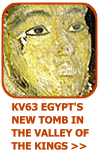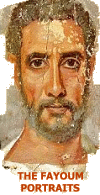|
|
|

featured temples: abu simbel | karnak
 |
| Abu Simbel in 1838. David Roberts' captivating lithograph of the facade of the great temple at Abu Simbel, half buried by the shifting deserts sands. |
What is it?
Re-discovered by Johann Ludwig Burkhardt in 1813, enveloped by the shifting sands, Abu Simbel is now a UNESCO World Heritage archaeological site. The site consists of of two massive rock temples located close to the town of Abu Simbel in southern Egypt (Nubia).
Where is it?
The temples are on the western bank of Lake Nasser, around 290km southwest of Aswan. Between 1964 and 1968, the entire complex was relocated 65m higher up and 200m further back from the river bank. This was to avoid the temples being totally submerged during the creation of Lake Nasser, the massive artificial water reservoir formed after the building of the Aswan dam on the river Nile.
 |
| The Great Temple |
The Smaller Temple |
Who built the temples?
The twin temples were carved out of the mountainside during the reign of Pharaoh Ramesses II, as both a lasting monument to himself and his principal queen Nefertari, and to commemorate the so-called victory at the Battle of Kadesh. As such, the sheer size and scale of the temples were also designed to intimidate his Nubian neighbours.
Who are they dedicated to?
The great temple is dedicated to Ra-Horakhty, Ptah and Amun, Egypt's three state deities of the time, and features four large statues of Ramesses II in the facade. The smaller temple is dedicated to the goddess Hathor, personified by Nefertari.


The great temple at Abu Simbel is generally considered to be the grandest and most beautiful of the temples commissioned during the reign of Ramesses II.
The facade:
The rock cut facade of the great temple represents the front of a pylon and is 33m high and 38m wide, guarded by four statues, each of which are 20m high. They were sculptured directly from the rock in which the temple was located before it was moved in the 1960's. All of the statues represent Ramesses II, seated on a throne and wearing the double crown of Upper and Lower Egypt. The statue to the left of the entrance was damaged in an ancient earthquake, leaving only its lower section still intact. Several smaller figures are situated at the feet of the four statues, depicting members of the pharaoh's family. They include his mother Tuya, wife Nefertari, and some of his sons and daughters. Above the entrance there is a statue of a falcon-headed Ra-Harakhte, with the pharaoh shown worshipping on both sides of him. Below the statue there is an ancient rebus, showing the prenomen or throne name of Ramesses II: "Waser-ma'at".
This fantastic facade is topped off by a row of 22 baboons, their arms raised in the air, worshipping the rising sun. Another notable feature of the facade is a stele that records the marriage of Ramesses II with a daughter of the Hittite King, Hattusili III, a triumphant diplomatic act that would seal the peace between Egypt and the Hittites.
 |
| The eight statues of Ramesses in the form of Osiris, from the first hall. |
The four seated statues in the sanctuary.
|
The interior:
The first hall of the temple features eight statues of Rameses II in the form of the god Osiris, serving as pillars. Those on the north side are shown wearing the white crown of Upper Egypt, whilst those on the south wear are wearing the double crown. The walls depict scenes of Egyptian victories in Libya, Syria and Nubia, including images from the Battle of Kadesh. At the western end of the main hall are three doors, the side ones leading into lateral chambers, and the central one opening into a room with four square pillars. From this room a doorway leads to the vestibule, and beyond that is located the innermost shrine with seated statues of the gods.
The sanctuary contains four seated statues of Ra-Horakhty, Ptah, Amun and Ramesses (see above). One of the most remarkable features of this temple is that it is so precisely oriented that twice every year, the first rays of the morning sun shine down the entire length of the temple-cave to illuminate the back wall of the innermost shrine and the statues of the four gods seated there. These dates were allegedly the king's birthday and coronation day respectively, but there is no evidence to support this. Due to the displacement of the temple when it was moved, it is widely believed that this event now occurs one or two days later than it was originally intended.


The smaller temple has a much simpler interior design than the great temple, having just one hypostyle hall and the sanctuary.
The smaller temple at Abu Simbel is located just north of the great temple. It was carved into the rock by Ramesses II and dedicated to Hathor, the goddess of love and beauty, and also to his principal wife, Nefertari. The facade is adorned by six statues, four of Ramesses II and two of Nefertari. Most unusually, the six are the same height, which indicates the esteem in which Nefertari was held. The entrance leads to a single hall, containing six pillars that bear the head of the goddess Hathor. On the sides facing the centre of the hypostyle hall, Ramesses is shown smiting his enemies and making offerings before various gods, whilst a graceful and slender Nefertari is shown with hands raised. Three doors lead to a vestibule with ancillary rooms at either end.
The holiest area of the temple, the sanctuary, has two spaces that were left on its side walls for doors to rooms which were never actually cut. The inner chamber contains a number of images interrelating the royal couple and the gods. On the back wall is a relief of the goddess Hathor, shown in the form of a cow emerging from the western mountain, with the king standing beneath her chin. Above the doorway is the cartouche of Nefertari. Ramesses II is also shown standing before seated figures of himself and Nefertari.
When Greek mercenaries passed by the smaller temple in the 6th century BC, sand already reached the knees of the facade statues. These ancient sightseers left an inscription which read "When King Psammetichus came to Elephantine, this was written by those who sailed with Psammetichus the son of Theolces, and they came beyond Kerkis as far as the river permits."
 |
| David Roberts' lithograph of the sand swathed Osiris statues from the first hall of the great temple at Abu Simbel in 1838. |
return to the main temple page >>
|
|
|














